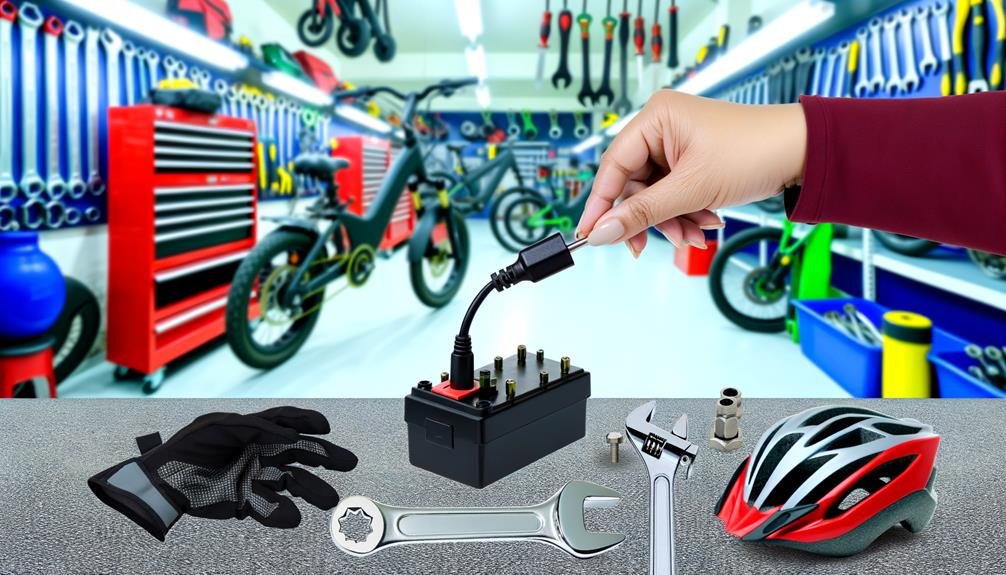Charles Miller is a veteran bike enthusiast with over 12 years of experience dealing with bikes as a mechanic. Despite immense love and expertise for...
In the realm of personal transportation, folding electric bikes have emerged as a convenient and eco-friendly alternative to conventional vehicles. These innovative machines blend the portability of traditional folding bikes with the power of electric propulsion.
However, one aspect of folding electric bikes that often gets overlooked is their weight. The weight of these bikes can vary significantly, influenced by factors such as frame material, battery size, and additional features. Understanding the weight implications is crucial for potential buyers, especially those who intend to carry their bikes up flights of stairs or transport them on public transit.
We invite you to join us as we explore this often under-appreciated aspect of folding electric bikes.
Key Takeaways
- Folding electric bikes can vary in weight due to factors such as frame material, battery size, and the addition of accessories.
- Frame material, such as rigid aluminum, is favored for its low weight and portability.
- Larger batteries provide extended range but also add more weight to the bike.
- Accessories like racks, fenders, and lights contribute to the overall weight of folding electric bikes.
Understanding Folding Electric Bikes
Navigating the complexities of folding electric bikes requires a thorough understanding of their various models, performance factors, and significant features. These bikes, often referred to as folding e-bikes, come in an array of models, each with unique specifications. Notably, the bike weight is a major consideration for potential owners. The ultimate electric bike should be small enough to be portable, yet robust enough to carry the rider over significant distances.
Models like the Blix Vika+ Flex and Lectric XP 3.0 Step-Thru are among the top choices due to their balance between weight and performance. The Blix Vika+ Flex, for instance, is known for its adjustable seat and handlebars, removable battery, and compact design. Similarly, the Lectric XP 3.0 Step-Thru offers an advanced LCD display for monitoring speed and battery life, providing riders with crucial real-time data.
Factors Influencing Bike Weight
The weight of a folding electric bike is significantly influenced by various factors including the bike's material, battery, and the addition of accessories.
Different materials used in manufacturing, such as aluminum or carbon fiber, have direct impacts on the bike's weight and durability.
The power and capacity of the battery, as well as any added accessories, also play substantial roles in the overall weight of the bike.
Bike Material and Weight
Given the diversity in folding electric bikes, factors such as frame material, battery size, and motor power play significant roles in influencing the overall weight of these bicycles.
- Frame Material: A folding electric bike with a rigid frame made from aluminum is favored for its low weight, contributing to the bike's portability.
- Battery Size: Larger batteries add weight to folding bikes, impacting their maneuverability and ease of transportation.
- Motor Power: More powerful motors can add significant weight to an electric bike.
- Model Specifics: The weight can vary among the 89 models of folding bikes, each having unique design features.
In selecting your folding electric bike, it's essential to balance these material and weight considerations with your specific requirements for durability and performance.
Battery Influence on Weight
In the realm of folding electric bikes, the battery's influence on weight emerges as a central consideration, with its size, capacity, technology, and placement collectively shaping the bike's overall heft and handling characteristics.
The battery energy, notably its Wh capacity, largely dictates the e-bike's weight. A larger battery, while providing extended range, indeed adds more weight, while a smaller battery makes for a lighter, more portable folding model.
The type of battery technology, often lithium-ion in the best folding electric bicycles, also impacts weight.
Furthermore, battery placement within the e-bike's frame can significantly affect weight distribution and handling, presenting a critical consideration when designing folding models.
Understanding these factors helps in selecting an electric bicycle that balances portability with battery performance.
Addition of Accessories
While the battery undeniably plays a significant role in determining the weight of folding electric bikes, another factor to consider is the addition of accessories such as racks, fenders, and lights, which can also contribute to the overall heft of these bicycles. Different models, from Blix Vika+ Flex to Aventon Sinch, Rad Power, Lectric XP, and XP Lite, offer varying types of accessories.
The cargo rack, often adjustable, can add a considerable amount of weight.
Adding fenders for protecting against mud or water splashes also contribute to the weight.
Lights, while necessary for safety, do add some extra grams.
Even small items like a velcro strap for securing the folded bike can add to the total weight.
Considering the weight impact of accessories is crucial for making an informed choice about folding electric bikes.
Average Weight of Folding E-Bikes
The average weight of folding e-bikes is influenced by various factors including the materials used in construction, the size and type of battery, and additional features like suspension systems.
A comparative analysis of different models such as the Blix Vika+ Flex, Rad Power RadExpand 5, Aventon Sinch Step-Through, and Lectric XP 3.0 Step-Thru reveals significant variations in weight.
This weight disparity can profoundly impact the performance of the e-bike, affecting aspects such as ride quality, range, power, and overall user experience.
Factors Influencing E-Bike Weight
Given the varying features and specifications, the weight of folding electric bikes can be influenced by several factors including motor power, battery capacity, frame material, and additional accessories. The e-bike market offers a range of options, from electric mountain bikes with robust frames and high-capacity batteries, to compact, lower price models easier to carry upstairs or hold the bike on public transport.
- Motor Power: Heavy-duty motors add weight but provide best class performance.
- Battery Capacity: Larger batteries extend range, but increase weight.
- Frame Material: Aluminium frames are lighter than steel, but less robust.
- Accessories: Every bike comes with optional extras like racks or fenders that add weight.
These aspects all contribute to the overall weight of folding e-bikes, and should be considered when seeking the best fit for individual needs.
Comparing Different E-Bike Models
Taking into account these factors that influence weight, it becomes crucial to compare specific folding electric bike models, focusing particularly on their average weights.
The Blix Vika+ Flex, similar to a Mountain Bike in its lightweight build, outperforms others with its smaller folded size.
The Lectric XP 3.0 Step-Thru, akin to a Fat Tire bike in terms of ride quality, offers excellent value and a suspension fork for improved ride experience.
The Aventon Sinch Step-Through, while offering a cushiony ride and exceptional miles on a single charge, weighs more and has a larger folded size.
Finally, the Rad Power RadExpand 5 provides fast acceleration, a generous speed limit, and easy assembly.
These comparisons assist potential customers in finding a model that suits their needs, offering excellent customer service.
Impact of Weight on Performance
While considering the average weight of folding electric bikes, it's vital to note that it significantly influences their performance, with lighter models often offering advantages such as quicker acceleration and more effortless transportation.
Weight impacts various aspects:
- Speed: Lighter bikes often achieve a higher top speed, thanks to less mass to propel forward.
- Ride quality: Lighter bikes usually provide a more comfortable ride, easily accommodating various rider heights.
- Power: Lighter bikes tend to have better pedal assist, with five levels of pedal assistance commonly available.
- Brakes: Regardless of weight, both mechanical disc brakes and hydraulic disc brakes fit on folding e-bikes, affecting their stopping power and overall safety.
In essence, weight plays a crucial role in the performance and convenience of folding electric bikes.
Benefits of Lightweight E-Bikes
The advantage of lightweight electric bikes manifests in several key areas such as portability, handling, rider strain, battery efficiency, and versatility, catering to a broad spectrum of user needs and physical capabilities. With their reduced weight, these bikes are much more manageable, making trips around the city or commuting to work an effortless task. A wide variety of individuals, regardless of their physical strength, find the convenience of a lightweight e-bike enough to make their biking experience enjoyable.
Handling is another area where lightweight e-bikes excel. They offer a smooth ride and are easy to maneuver, reducing rider strain. The LCD screen and LED display are user-friendly and intuitive, further enhancing the riding experience. We've tested these bikes and found that they also have improved battery efficiency due to their decreased overall weight, which extends their range and performance.
Moreover, lightweight electric bikes possess a wide range of versatility. They cater to a broad spectrum of user needs, from the casual rider to the more adventurous. The goal of this article is to help you find the right bike that aligns with your needs, providing an inclusive sense of belonging in the e-biking community.
Comparing Top Folding E-Bike Models

Building on the advantage of lightweight e-bikes, let's now explore and compare some top folding electric bike models in terms of weight, performance, and additional features.
Understanding the weight and performance characteristics of folding e-bikes provides insight into how well a bike fits different riders, especially taller riders, and how it handles around town.
For those desiring a smooth and pleasant ride, the suspension system and seat post design are critical considerations.
- Blix Vika+ Flex is a lightweight option that offers quick acceleration and a solid range. Its packed feature set, including magnets that help secure the fold, make it a top performer.
- Lectric XP 3.0 Step-Thru stands out in its price range for its excellent value, improved ride quality, and easy assembly.
- Aventon Sinch Step-Through, while slightly heavier, provides a shock-absorbing ride and an exceptional range. Its design is streamlined and stylish.
- Rad Power RadExpand 5 is known for its fast acceleration, comprehensive feature set, and capacity to accommodate a wide range of user heights.
Tips for Handling E-Bike Weight
Navigating the intricacies of e-bike weight can significantly enhance your riding experience, as factors such as the bike's weight, folded dimensions, and weight capacity play pivotal roles in determining its handling, portability, and suitability for different users. For stable handling on dirt roads, a folding electric bike with a sturdy frame and a suspension fork would take preference. Knobby tires can provide extra traction, and a good braking system boosts the stopping power necessary for mountain biking.
Here are some tips to guide you in handling e-bike weight:
| Consideration | Why It Matters | Example |
|---|---|---|
| Bike's Weight | Influences handling, portability, and user suitability | Lightweight aluminum frame |
| Folded Size | Determines storage convenience | Compact folding mechanisms |
| Weight Capacity | Ensures the bike can support different users | High-capacity e-bikes |
| Durable Components | Promotes stability and longevity | Durable frame and components |
| Added Features | Enhances portability and handling | Foldable pedals, adjustable parts |
Frequently Asked Questions
What Is the Average Weight of a Folding Bike?
The average weight of a folding bike is influenced by design, material selection, and dimensions. While portability demands weight reduction, durability concerns may increase weight. Variations exist, but weight notably impacts the bike's overall performance.
What Is the Average Weight of an Electric Bike?
The average weight of an electric bike, factoring battery weight, electric motor, and bike materials, typically ranges from 35 to 60 pounds. Weight considerations include capacity for heavy riders, weight reduction, portability, and weight distribution.
What Is the Lightest Electric Foldable Bike?
The Blix Vika+ Flex, known for its superior battery longevity, portability, and speed capabilities, stands out as the lightest electric foldable bike. Its efficient charging times, durable foldability mechanisms, and safety features further enhance its appeal.
Are Electric Bikes Heavy to Lift?
The weight of electric bikes varies, impacting lifting techniques, portability, and storage. Strength requirements depend on the bike's durability and frame materials. Weight can affect mobility considerations and transportation issues. Proper lifting is essential to protect the rider.
Conclusion
In conclusion, the weight of folding electric bikes varies greatly, influenced by factors such as design, materials, and additional features.
While lightweight models offer portability and ease of handling, heavier models may provide enhanced stability and durability.
It is, however, crucial for potential buyers to balance these factors with their individual needs and preferences, ensuring a comfortable and efficient ride.
Despite the seemingly daunting weight, the benefits and convenience of folding e-bikes undeniably offer a compelling argument for their adoption.

Charles Miller is a veteran bike enthusiast with over 12 years of experience dealing with bikes as a mechanic. Despite immense love and expertise for his Tacoma, he rides his Trek Ebike more. Anytime you meet him, you’ll either hear him talking about Bikes, or writing about all things bikes and cars on this blog.
More Posts


